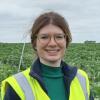The main nutrients plants obtain from soils are nitrogen (N), phosphorus (P) and potassium(K).

Soil is a major source of nutrients needed by plants for growth.
Recommended Content
Content below is from across the PEP community and is not necessarily endorsed by Stewards or by PEP
Connected Content
The intricate web of relationships between physical, chemical and biological soil components underpins crop and livestock health and productivity.
There is a lot of interest in soil carbon currently, due to the opportunity to store and sequester carbon in soil. It is also vital for soil health, forming part of soil organic matter.
The 18th Recycling of Agricultural, Municipal and Industrial Residues in Agriculture Network (RAMIRAN) conference will be held in Cambridge, UK from 12–14 September 2023. All sessions will be held in the heart of Cambridge at the Guildhalls and Corn Exchange.
Introduction Climate change will significantly impact agriculture, forestry and the food industry, and the impact will change over time. The change in local and global climate conditions will impact the life cycle process of the agriculture and food industry, including the quality of seeds, growing seasons, crop maturity, livestock productivity, forest productivity, etc. The most critical impacts are the increased CO2 emissions due to growth in agricultural activities, the changing rainfall patterns, increased evaporative demand, reduced water availability for irrigation threatening all agricultural production, extended or repeated periods of drought, tree deaths, increased flooding, including that caused by sea-level rise, substantial losses in crop production in low-lying agricultural areas, soil compaction, waterlogging and soil erosion, and pests and diseases threatening the production. Climate change will affect the range and quality of the ecosystem services that agriculture and forestry provide and rely on. They provide climate control, flood regulation, biodiversity, pollination and nutrient cycling. These sectors play a critical role in adapting to the change by introducing new healthy and resilient genotypes, varieties, breeds and management practices. As the impact of climate change continues to be severe, there is a need for more anticipatory adaptation measures. Agriculture and forestry are components of larger biophysical, social and economic systems, reacting and adapting to climate change in different ways, resulting in complex global changes whose impacts at the local level are not easy to predict. Conversely, the demand for agriculture and the food industry is growing, including to achieve the ‘No Hunger’ SDG 2 target, universal access to safe and nutritious food, end all forms of malnutrition, double the productivity and incomes of small-scale food producers, sustainable food production and resilient agricultural practices, maintain the genetic diversity in food production, invest in rural infrastructure, agricultural research, technology and gene banks, preventing agricultural trade restrictions, market distortions and export subsidies, and ensuring stable food commodity markets and timely access to information. Thus, achieving food and nutritional security by increasing crop productivity while limiting carbon emissions is of utmost priority for every nation. This includes strengthening sustainable agri-food value chains, scaling up agri-food systems resilience, improving food security, and generating employment. While doing this, we must increase innovative practices and the creative and entrepreneurial skills of farmers worldwide to do their jobs and businesses effectively, foresee future scenarios and be prepared and resilient to climate and economic shocks. This highlights an urgent need to identify an eco-friendly/cleaner consumption and production system that is more productive, profitable, resource-efficient (i.e. efficient use of energy, water, and carbon-based inputs), environmentally safer, balanced gender, accessible and inclusive of everyone, and resilient. Communities Carbon Calculator (CCC) Pilot Our proposal, Communities Carbon Calculator, is about designing eco-friendly and carbon-cum energy efficient, resilient and sustainable production and consumption systems for the diverse agroecosystems worldwide. The primary concept is to have meaningful, interrelated, inter-sectoral collaborative four (4) Carbon Interventions: Carbon budgeting includes carbon reduction, using embodied carbon and reducing carbon waste for positive impact. Carbon mobilisation includes understanding the carbon dynamics throughout the processes, practices and products and applying technologies (natural, bio, chemical, mechanical, etc.) and fixing it for positive impact. Carbon literacy includes increasing the understanding and knowledge of the use of technologies (digital), theories and practices for a sustainable and resilient low-carbon sector. Carbon Sustainability includes developing local and global ecosystems for sustainable and resilient sectors. CCC Pilot will focus on 1 region and four countries in this Pilot. However, we are open to more countries or regions joining the Pilot. We have started collecting interest from the global community, and if we get 20 stakeholders from a country, it will be included in the pilot. For now, we have committed interest from: Region: The Congo Basin Countries: Democratic Republic of the Congo, Ouganda, Kenya, Ghana, Pakistan, Nigeria, Zambia, and Mongolia The Global Sustainable Futures Progress through Partnerships Network calls partners/collaborators/individuals to join the optimised integrated COMMUNITIES CALCULATOR CARBON (CCC) Pilot. For Africa, our foremost partner is Actions for the Development of Africa - ADA, led by Bernard K. Mulenda. He is closely working with Professor Dr Mylor Ngoie on the interventions from the Universities over the region. Country Carbon Calculator (CCC) Pilot will drive total transformation in systems at the country level. It will impact many other interrelated sectors, such as agriculture, water, waste, transport, energy, health, etc., developing in-country projects and integrating strategies for technology, subject expertise, innovation and commercialisation, including: Identifying and connecting with relevant stakeholders physically, socially and virtually, both at local, national and regional levels Advocating, encouraging, and negotiating with stakeholders to get involved in the program for managing carbon emission, business and innovative commodities, adopting an integrated approach and multi-area agreements Creating local, national and regional forums to attract all stakeholders (start-ups, technicians, experts) associated with business Facilitating carbon calculator development in-country, partnering with subject matter experts, academia, and technology experts The Carbon Calculator will be an online tool enabling every business manager detailing and supply chain actors to calculate the greenhouse gas (GHG) emissions and carbon storage into soil and biomass on the land area they are footprinting. It will account for all types of agriculture, food production and land use, producing a carbon balance detailing emissions into Scopes 1,2,3 emissions and carbon storage. A noticeable difference will be reflected in the quality of services, commercialisation, certification, carbon credits, crop diversity and inclusion of farmers, women and youth A scalable and innovative approach to connecting the countries as low-carbon, resilient and sustainable environmental, agriculture and food suppliers, health, manufacturing, etc. Seven WorkPlans WP1: To map the current resources in your country to create a farm carbon calculator WP2: To build a working model for piloting the carbon calculator WP3: To evaluate the CCC Pilot quarterly for its delivery of services/products/processes WP4: To measure the changes in the sector due to the innovative practices developed through CCC Pilot WP5: To measure the changes in related sectors such as agriculture, water, energy, transport, health nutrition, soil quality, housing, etc. through CCC Pilot WP6: To develop the learning/skill development/innovative practices knowledge exchange gathered through CCC Pilot WP7: To work with the stakeholders to improve decision-making for a resilient and sustainable industry Please complete this form to express your interest: https://docs.google.com/forms/d/e/1FAIpQLScpkme0WNS-th6QGNcTTJ6d9vMZa2myFBixszOD4YYDLRq9Mg/viewform?usp=share_link Contact Dr Renuka Thakore, Founder and CEO, Global Sustainable Futures Network CIC, UK [email protected] https://www.linkedin.com/in/rbthakore/
MINAGRIS is an EU-funded project which is aiming to contribute to healthy soils in Europe by providing a deeper understanding and tools to assess the impact of microplastics and nanoplastics in agricultural soil health.
The 18th Recycling of Agricultural, Municipal and Industrial Residues in Agriculture Network (RAMIRAN) conference was a resounding success. See selected resources from the conference below.
Routine topsoil samples should be taken from all fields for analysis of pH, P, K and Mg every 3-5 years. Accurate information on soil nutrient Indices and soil pH is essential for nutrient management planning. Various approaches and services are now available for in field mapping of soil nutrient availability.
Open access text book comprehensively reviewing advances in potassium science and potash fertilizer . Murrell, T.S., Mikkelsen, R., Sulewski, G., Norton, R., Thompson, M. (2020) Improving Potassium Recommendations for Agricultural Crops. Springer. https://doi.org/10.1007/978-3-030-59197-7
We are pleased to announce that the next British Society of Soil Science Annual Conference will be a joint event with the Soil Science Society of Ireland and take place in Belfast on Monday 4 and Tuesday 5 December 2023.
The Nutrient Management Guide (RB209) helps you make the most of organic materials and balance the benefits of fertiliser use against the costs – both economic and environmental.
6 October 2023: AFBI Soils Conference - La Mon Hotel and Country Club, Belfast
Combining Agronomic and Technical presentations. The Society’s 2023 Conference will be held at Robinson College, Cambridge, UK on 6-8 December
Soil Fungal Communities Project to establish the level of arbuscular mycorrhizal fungi (AMF) in arable soils across a range of locations, soil types and management systems.
Soil is the basis of every grassland system and aiming to constantly improve soil health will pay dividends in grassland productivity.
Arbuscular mycorrhizal (AM) fungi and crops can work together for mutual gain. A new PhD studentship report examines how these crop-friendly fungi can be nurtured by management.
The ADAS soils and nutrients team will share and discuss results from our recent cover crop research with Affinity Water, Anglian Water, and Portsmouth Water.
Interested in learning more about home grown protein crops but don’t know where to look?
Among legume crops, forage peas and field beans show the most symptoms of legume fatigue.
Catch crops are grown post-harvest or following silage, these crops hunt nutrients to reduce leaching from the soil while also allowing cover for the soil which prevents erosion.
In October 2023 on behalf of AgriSearch, ADAS soil scientists conducted a full review of Nutrient Management Planning Tools (NMPTs) available for forage crops in Northern Ireland.
Six Simple Steps for your soil to help improve the performance, health and long-term sustainability of your land
Nitrogen (N) is not a scarce element on earth but the most abundant forms (N2 gas in the atmosphere and N fixed in the earth’s crust and sediments) are not directly available for plants.
Adding organic materials can potentially lead to better drainage, more resilient soil, more efficient irrigation, higher crop yields and better crop quality.
Farmer: Ian Lutey - Cambridgeshire
Join this webinar to hear from monitor farmer David Cross and independent consultant Dr Liz Genever as we discuss soil health and other updates from the Monitor Farm.

